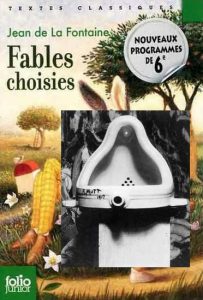TPE: Emblem 3, Readymade
Readymade: Found Emblems. Modernist experimental vanguard arts invented the operating practices (logic) of electracy– collage montage, cut and paste, creating meaning through appropriation and arrangements drawn from the archive of popular and commercial media circulating ubiquitously in the recording technologies invented as part of the industrial revolution. Konsult extends this formal practice (Dadaism, bachelor machine) into education and pedagogy. Egents designing wide images may learn from the likes of Marcel Duchamp how to author and design with image apps.
 –Fable: What resources are available for inquiry and expression in the conditions after Nietzsche, the history of an error, after the simultaneous withdrawal of the true world and the apparent world along with it? The time is noon (the shortest shadow). What remains is fable, Nietzsche said. What are the possibilities of fable as genre? Duchamp improvised one approach, perhaps not even yet fully appreciated. His Readymades are fables, albeit weak (faible) fables, in that they provide the illustrations only (the emblems, impresas). He intimated his variation on the mode with his most notorious instance, whose title “Fountain” translates “La Fontaine,” antonomasia between common and proper noun, evoking the name of the author of many fables in the common “fountain,” itself a euphemistic title for a urinal. Ulmer’s collage of the urinal with a cover of La Fontaine’s book make the joke explicit. Duchamp’s commitment to the punning bachelor machine logic central to modernism is well known. He acknowledged his attendance at a performance of a stage adaptation of Raymond Roussel’s 1910 novel Impressions of Africa as a turning point in his career (Roussel’s method of composition used generative puns). It has been suggested that some of the Readymades at least are comments on dreams described in Freud’s Interpretation of Dreams, hence that they use rebus methods (visualizations evoking words). Freud noted, for example, that many dreams are triggered when sleepers experience the need to urinate (the dream allows sleep to continue briefly). The text of the fabled fountain is provided by its history, being as it is the most influential (if not the “best”) art work of the twentieth century, including its status as a prank, and all the manipulations Duchamp performed to put the image of La Fontaine into circulation, recorded in Thierry De Duve’s Kant After Duchamp. What is the moral of the readymade fable?
–Fable: What resources are available for inquiry and expression in the conditions after Nietzsche, the history of an error, after the simultaneous withdrawal of the true world and the apparent world along with it? The time is noon (the shortest shadow). What remains is fable, Nietzsche said. What are the possibilities of fable as genre? Duchamp improvised one approach, perhaps not even yet fully appreciated. His Readymades are fables, albeit weak (faible) fables, in that they provide the illustrations only (the emblems, impresas). He intimated his variation on the mode with his most notorious instance, whose title “Fountain” translates “La Fontaine,” antonomasia between common and proper noun, evoking the name of the author of many fables in the common “fountain,” itself a euphemistic title for a urinal. Ulmer’s collage of the urinal with a cover of La Fontaine’s book make the joke explicit. Duchamp’s commitment to the punning bachelor machine logic central to modernism is well known. He acknowledged his attendance at a performance of a stage adaptation of Raymond Roussel’s 1910 novel Impressions of Africa as a turning point in his career (Roussel’s method of composition used generative puns). It has been suggested that some of the Readymades at least are comments on dreams described in Freud’s Interpretation of Dreams, hence that they use rebus methods (visualizations evoking words). Freud noted, for example, that many dreams are triggered when sleepers experience the need to urinate (the dream allows sleep to continue briefly). The text of the fabled fountain is provided by its history, being as it is the most influential (if not the “best”) art work of the twentieth century, including its status as a prank, and all the manipulations Duchamp performed to put the image of La Fontaine into circulation, recorded in Thierry De Duve’s Kant After Duchamp. What is the moral of the readymade fable?
____________
 –Martin Kippenberger, “Rameau’s Nephew,” 1988
–Martin Kippenberger, “Rameau’s Nephew,” 1988
A few minor changes and some careful wallpapering are quite enough to lend a mundane and utilitarian item a touch of sophisticated polish or at least a bit of homely comfort. The result of these efforts arouses ambivalent feelings of embarrassment and admiration. The beautiful wallpaper heightens the esthetic ineptitude of the box to the point of unbearable bleakness and yet a conciliatory glow seems to emanate from the depths of its decoratively enhanced ineptitude. The man in the wallpaper obviously has no such ambivalent qualms; he only wants to to eat (his noodles?) in peace. Perhaps he mirrors the imperturbability that Martin Kippenberger highlights in his art as a means of reconciling us with the ubiquity of embarrassing banality.
According to literary history, Rameau’s nephew was a Bohemian without character but not without talent, who was plunged into misery upon the death of his wife and children. Diderot’s novel of the same name depicts him as a cynical parasite and a brilliant failure, in short, a paradoxical protagonist beyond good and evil.
Patrick Frey, “Whereof one cannot speak, thereof one should not be silent,” in Parkett. 19 (1989). Observe in Kippenberger’s example the enigma created in what he called the interval–the art of Readymade composition is to create an interval between a title (functioning as motto) and an image or object; in this case between the evocative “Rameau’s Nephew,” and a packing box lined with wall paper. The instruction from the artists is not “look how beautiful,” but “everyone an artist” (literally the motto of Joseph Beuys).
